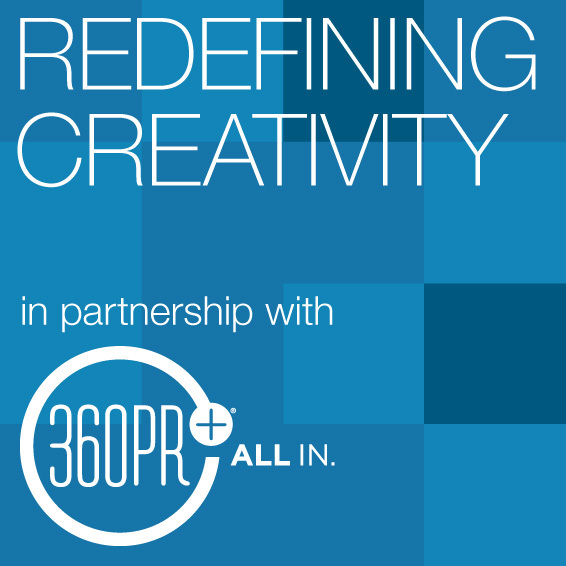Mark Henricks 18 Oct 2019 // 3:03PM GMT

It’s hard to be creative when you keep doing things the way you’ve always done them. So in addition to conventional approaches to spurring creativity – brainstorming comes to mind – professional communicators who value creativity are looking for ways to shake up the creative process.
“Creativity has always been about breaking the rules and inventing new ones,” says Erin Weinberg, general manager of the New York office for 360PR+. Her favorite recent example: Burger King’s “A Day Without Whopper” September 2019 promotion when its restaurants in Argentina stopped selling Whoppers for a day. Instead, customers were re-directed to McDonald’s, which was donating $2 to prevent children’s cancer for every Big Mac sold.
Identify opportunities to be gained if core assumptions in the industry or company were false.
“Imagine turning your customers away for something more noble,” Weinberg muses. “Now that’s true disruption.” But steering customers to competitors is just one innovative way to approach innovation itself.
Recipes for Creativity
Adam Brandenburger, a professor at the New York University Stern School of Business who researches, writes and teaches about creativity, suggests two teams can strategize more creatively than one. Team A lists the strengths in your organization. Team B lists weaknesses. Then the teams swap lists.
“Ask Team B to argue that the strengths listed constitute threats to the organization’s future, and Team A that the weaknesses listed constitute opportunities,” Brandenburger says. “Next, do a similar external analysis: Ask Team A to list all the strengths it sees in your competition, and Team B all the weaknesses.”
“Again, have the teams swap lists,” Brandenburger says. “Ask Team B to argue that the strengths listed are opportunities for your organization, and Team A to argue that the weaknesses constitute threats. This exercise can open your eyes to many possibilities that otherwise might never occur to you.”
Brandenburg also suggests identifying opportunities to be gained if core assumptions in the industry or company were false. Altering normal work patterns can break up ingrained assumptions and groups with diverse expertise and experience can also more effectively brainstorm, he says.
Another approach is to impose constraints to encourage people to find new ways of thinking and acting. Creativity can even come from coordinating with providers of complementary products, even competitors, Brandenburger says.
Brainstorming Tweaked
One of the central tenets of brainstorming is “there are no bad ideas,” which overlaps with moving participants from the “yes but— ” mindset to “yes, and —.” Interestingly, a recent Harvard Business Review article challenges this assumption and maintains that criticism is actually good for creativity. Authors Roberto Verganti and Don Norman make the case for combining those two for a “yes, but, and” approach. Another recent article advocates for agenda-less meetings because “a preset agenda will bias the outcome and undermine the group’s ownership over the process.”
Dan Mazei, head of global communications for Activision Blizzard Esports, has seen good results from making small changes to the format of regular brainstorming sessions. Relatively minor changes keep brainstorming from becoming tedious and laborious, he says.
“When you’re already in a lot of meetings, adding another meeting to the day to be creative can be almost counterintuitive,” Mazei says. “The onus is on leaders to break up the monotony of brainstorming and introduce new variables to get people out of a formulaic way of thinking.”
Creativity starts with attention, always
For Mazei, format changes don’t have to be sweeping. “If it’s usually a full team brainstorm, maybe you break it down to small groups this week,” he suggests. “Or you change the geography. If you’re typically in a meeting room, take it outside if it’s a sunny day. Roll the white board outside.”
Mazei has gone as far as cutting news items into slips of paper and placing them in a bowl, then filling another bowl with slips containing different holidays. Then he asks people to draw slips from each and come up with ideas. “That sounds silly, but it has come up with some terrific ideas we ended up executing, just by changing the format to get people to think a little differently,” he says.
The Importance of Being Open
In The Art of Noticing, released earlier this year, author Rob Walker says creativity is best spurred by making observations — which is becoming increasingly challenging in today’s frantic world where elaborate battles are being fought for our attention. “Creativity starts with attention, always,” Walker says in a Q&A with Porchlight Books. “And what matters in almost any field—whether you’re a scientist, a coach, an entrepreneur, a manager, or a journalist like me—is noticing what other people overlooked. That’s the first step to crafting an original point of view on the world, and breaking from the pack, which is the ultimate competitive edge.”
At 360PR+, for instance, Weinberg employs this concept of mindfulness to spice up staid brainstorming. “When we are mindful, our brains can think more clearly and with greater imagination,” she explains. “So, by practicing mindfulness before or as part of a brainstorm session, it can help us be aware and, in the moment. I think it’s a great thing.”
For Weinberg, open-mindedness is also a core requirement for creativity. That applies to ways of improving creativity as well as ideas from individual brainstorming sessions. “Everyone has a different approach so I’m always open to hearing about what works for others,” she says.
Weinberg also turns to images as a source of inspiration. “I’m very visual,” she says. “I’m constantly jotting down ideas, doodling, recreating logos, etc. For brainstorming sessions, I think it helps for people to see images and content that could inspire them as ideas come from lots of different places. One of the first things I did when I joined 360PR+ as general manager of the New York office was identify which walls to paint with white board paint. And in a pinch, I’ve been known grab a dry erase marker and start writing on a clean window.”“
The Diversity Dynamo
Clearly, multiple paths can lead to creativity, and Sukhi Sahni, consumer card PR leader and senior director at Capital One tries to use many of them. She lists forming diverse groups, encouraging free exchange of ideas and being open to even slight improvements in creativity – as opposed to looking only for groundbreaking innovation – as techniques at the center of her approach.
Sahni’s creativity strategy relies heavily on environment, specifically creating one where people of varying backgrounds feel confident about sharing ideas with others. “Be open to ideas coming from people who are very different from yourselves,” she advises.
Inspiration can come from anywhere, Sukhi emphasizes, even the seemingly sterile field of data mining. “We’re constantly looking into insights from data,” she says. “How are our customers behaving? Are there data pieces we can leverage and see a trend?” Data-backed creativity particular helps when working with journalists, she says.
Whether the original source is data or day-dreaming, Weinberg agrees that giving every creator and idea a chance is crucial. “When it comes to the creative process, it must be a safe zone where people feel comfortable taking risks and saying what’s on their mind,” she says.
Creativity Caveats
Even the most creative ideas aren’t helpful, however, if they don’t solve the business or communications challenge, Weinberg notes. “This is why a good creative brief is so important—it grounds everyone from the start of the assignment and ultimately fosters even better ideas,” she says.
“Before we get in the room, we determine what we know and what we need to know about the company, the category, the competition and customers – we call that our 4Cs at 360PR+ – to be able to reach and appeal to new customers,” she says. Information pulled into that brief comes from customer reviews, media coverage of the brand and its space and other topics important to the audience the brand wants to serve, Weinberg says.
While the creative brief guides idea adoption, it’s still important to be receptive to all ideas. “Closed minds kill creativity,” Weinberg says. “Open minds and checking any preconceived notions at the door are critical and that’s agnostic for brands and agencies. Not every idea can work but every idea is worth considering. If ideas automatically get shot down, you may never get to something that sparks an idea that is worth building on.”
This article is the first in a series exploring the topic of creativity in partnership with 360PR+. You can read more from the series here.


































.jpg)


















